In this episode, Dr. Ron sits down with Laura Vasquez, MSN, APRN, NP-C,to discuss some of the myths around breast cancer and ways to prevent it naturally. They talk about the book Busting Breast Cancer by Susan Wadia-Ells and the research that has been done on prevention.
Thank You To This Episode’s Sponsor
Episode Transcripts
Disclaimer: The information contained on the Real Health Podcast. And the resources mentioned are for educational purposes only. They are not intended as, and shall not be understood or construed as medical or health advice. The information contained on this podcast is not a substitute for medical or health advice from a professional who is aware of the facts and circumstances of your individual situation. Information provided by hosts and guests on the Real Health Podcast or the use of any products or services mentioned does not create a practitioner-patient relationship between you and any persons affiliated with this podcast.
Intro: This is the Real Health Podcast brought to you by Riordan Clinic. Our mission is to bring you the latest information and top experts in functional and integrative medicine to help you make informed decisions on your path to real health.
Dr. Ron: Well, welcome everyone to the Riordan Real Health Podcast. And this is Dr. Ron Hunninghake. And I have as my guest today, a nurse Laura Vasquez, who’s a nurse practitioner and she is joining me today to discuss a book that we have both looked over very carefully. And we think it’s relevant to many, many women. Well, first of all, let me say hi to Laura. How are you doing Laura?
Laura Vasquez: Hi, Dr. Ron, nice to be with you today.
Dr. Ron: You back, And I’ll bet you, a lot of people don’t know you yet, even though you’ve done a podcast. So Laura is one of our newest employees at the Riordan clinic. She’s a Nurse practitioner, and she’s in the Overland Park office. And where we kind of got off on the idea of doing this, this particular topic on Busting Breast Cancer, which is a new book that’s out, is that I had to do a talk down in Scottsdale, Arizona, and Laura was very helpful to me in terms of putting that talk together. So Laura, thank you. It went really well. And I appreciate all, all your, your due diligence in this.
Laura Vasquez: Thank you. It was great collaborating with you, Dr. Ron,
Dr. Ron: So Busting Breast Cancer, why don’t you just kind of jump in and maybe tell a little bit about this book as it relates to the whole issue of breast cancer in America today?
Laura Vasquez: Sure. So this book gives a vast array of evidence showing simple noninvasive, non-toxic ways to prevent or lower your risk of breast cancer, while also exposing the corporate industries who continue at advancing their political and, I would say, personal agendas which are putting women at a higher risk now more than ever to develop breast cancer. The author Susan Wadia-Ells is an advocate for all women to educate and empower us to take action and protect ourselves from these very industries that we’re supposed to trust. So this book goes through about five preventative steps that she thought were most important that all women could become more educated on and take steps towards working towards to prevent breast cancer.
Dr. Ron: It’s really important. I was just on a Zoom call with Dr. Tim’s Lucas Tim’s, who’s the naturopathic oncologist there in Overland Park. And we were talking specifically about the statistics surrounding breast cancer. It’s the number one cause of cancer death in women in the United States. And so, and it’s kind of just been that way. It actually continues to get a little worse over time. I know right now it’s one in eight women will, is it die from breast cancer, or is it we’ll get breast cancer? I can’t remember.
Laura Vasquez: I believe it’s die from breast cancer.
Dr. Ron: Yeah. Yeah. And it’s that’s, that’s, that’s staggering. That is just staggering. And so I think, what I got from one of the main ideas of this book is that there are five ways that women can reduce. Well, first of all, not to become one of those statistics and take better care of themselves, inform their family, their children, their friends that they can be more empowered and survive. What appears to be another pandemic, a scourge in terms of a menace to the lives of women, not just in the United States, but all around the world.
Laura Vasquez: Yes, you’re absolutely right. This is such an important topic. So I’m so happy we’re getting to do this, especially during breast cancer awareness month.
Dr. Ron: That’s right. I knew there was a reason why we put this on as well. So what we want to make women aware of is that they have the power to markedly reduce. And in this book, the author Susan Wadia-Ells, she boldly says that perhaps an 70 to 80% reduction in breast cancer cases, if women would just really carefully look into these five preventive steps, which is really another very astounding thing. I mean, the, the, the fact that we have this many deaths from breast cancer, but that we have women and the men in their lives who care for them and can help them to take these steps in order to reduce that, that awful statistic.
Laura Vasquez: Yes. Yes, definitely. And we can kind of maybe go into talking briefly about these five steps to get this education out to our listeners.
Dr. Ron: Right. I’m going to just give a quick introduction to the first one; you know, most people wonder what is cancer, and in the introduction of the book itself, there’s a pretty astounding idea that I think most people won’t know about. It’s been considered a form of altered genetic function that genes have gone wild and gone rogue, and now they’re creating cancer cells. And which sounds like the invasion of the body snatchers to me, like you’re, you’re really out of control. This is just going to happen, bad luck, too bad, and really the new research on the mitochondrial cause of cancer, namely that if there’s a lack of adequate oxygen to the mitochondria, these will start to malfunction. And it’s from there that the cells shift into a type of different type of metabolism that initiates the growth and spread of the cancer cells. And that this change can be mitigated against, by looking at the terrain of the cells. In other words, the factors that influenced the growth and health of ourselves that we have control over can help us reduce risk. And even if the cancer does come into our lives, there are very specific steps we can take to help return those cells to more normal functioning. So with that, with that kind of introduction, the first, the first preventive step is to eat fat, to lose weight, and keep the mitochondria healthy and happy with either a ketogenic type diet, weight loss. And I’m going to throw in there, intermittent fasting. So this may be new information to people. So, Laura, what is, what does this mean to you? Why would eating fat to lose weight? You know, a lot of people would say doesn’t fat make you fat.
Laura Vasquez: Yes. You know, growing up and, and I don’t want to date myself, but in the eighties and nineties, there was a fad diet of low fat diet. So I grew up with other low-fat foods and hearing about “don’t eat fat”. Now we know, and we knew back then as well. It’s just the information wasn’t out that if you aren’t eating healthy types of fat, you’re actually burning a much cleaner fuel source for your body, for your cells. You know, we run on either glucose or a fat metabolism. So we have two different types of metabolism and, you know, eliminating that sugar from your diet, those refined carbohydrates, allowing your body to burn more healthy fats. So doing a more ketogenic diet approach, you’re really giving your body cleaner fuel, and that can help people who are obese, overweight, burn, excess fat for energy so that they can be leaner. And they don’t have that inflammatory obese, there’s inflammatory obese cells in their body that can be a precursor to, you know, a toxic state, which is another risk factor for breast cancer.
Dr. Ron: Yeah. And just to even make this more general, a lot of times when people hear the word ketogenic diet, they say, well, I’ve heard, that’s just a lot of meat, and it doesn’t sound very healthy to me. Really what we’re talking about is more like a Mediterranean ketogenic diet, where the fats that are in the diet are omega-3 three type fats. And the fats that are, that are otherwise, there are from nuts, seeds and other healthier plant sources of, of fats. Not that there can’t be small amounts of beef or chicken, but you want to make sure that these other sources of fat are clean because we’re going to get down to one of the other big factors in, in her five steps is, is we want to avoid toxic influences because toxins are another factor here. So, but anyway, the main point is that this is not a specific diet. It’s more cleaning up the diet that you’re eating because so many of the processed foods that people buy now are overloaded with sugars. And, and then the types of fats that are more likely to cause problems with people. So so any other thoughts on oh, and then the intermittent fasting, what’s your take on intermittent fasting, Laura?
Laura Vasquez: I absolutely love intermittent fasting, and I practice this myself and advocate for a lot of my patients to practice this. There’s different ways you can do intermittent fasting. You can do a 24 hour fast once a week. You can do a 12 hour fast. So pretty much while you’re resting at night after dinner, you know, you’re just not eating until breakfast. You can eat. You can try to extend that, you know, you can do 16, 18 hour fast. Fasting helps your body rest, digest, and clean up old, you know, inflammation, old cells. So it’s a very powerful and easy tool to adopt into your lifestyle that can help with weight loss and help with inflammation in general. So, yes, definitely good to incorporate.
Dr. Ron: It also makes you feel better too. I know a lot of people are tired. Women, men are really tired and the idea has been, just eat more frequently throughout the day, but that keeps you in the carbohydrate burning mode. And if you don’t get the efficiency of a fat burning that you can by practicing intermittent fasting.
Laura Vasquez: Wow. That’s great.
Dr. Ron: Okay. The second item is something that I’m, I’ve been very interested in and been working with my patients for the last 10 years. And that is the importance of measuring your vitamin D level twice a year. Why do you think she’s saying measure it twice a year? What wouldn’t a lot of people say, “Well, I’m out in the sun quite a bit. I probably have enough vitamin D.”
Laura Vasquez: Yeah. You know, I think people don’t think of a maybe, or know the importance of vitamin D and all the functions that it has in our body. And so living in the Northern Hemisphere, we often don’t get enough natural sunlight year round. We also wear sunscreen, which blocks synthesis of vitamin D. And there’s been a lot of studies that show that the majority up to 80% of the population is vitamin D deficient. So then the studies also looked at vitamin D levels with cancer and breast cancer and women with breast cancer had an average vitamin D level of 17.
Dr. Ron: Ooh. And what we’re shooting for is a greater than 60 anagrams per ML. So the idea of measuring this is very much a Dr. Riordon idea that you really can’t manage something unless you measure it. And so people oftentimes say, well, I think I’m getting enough vitamin D, or they’re making that assumption, but in an area as that says important as this is measurement is key, because then that way, you know, whether or not you’re getting enough sunshine, or if you’re not supplementation can be accomplished very inexpensively and very safely, especially now that we’re advocating using low doses of vitamin K2, MK seven, along with the D3, you really don’t have to worry about excessive calcification in your body, which used to be a concern of conventional doctors.
Advertisement: There’s a lot more to this conversation, and it’s coming up right after the break.
Today’s episode of the Real Health Podcast is brought to you by the Riordan clinic nutrient store. The nutrient store is your resource for the highest quality nutritional supplements. Every supplement in this store is handpicked by the expert medical staff at Riordan Clinic, providing you with the best quality purity, consistency, and effective dosing available visit store dot Riordan clinic.org to shop online.
Laura Vasquez: Yeah. So it’s, yeah, like you said, it’s so easy to check your levels and that way we can titrate doses based on your specific level to get you to at least 60. Sometimes we like it even higher than that, depending on the patient, the situation, this is a very easy risk factor to control for all women.
Dr. Ron: Very good. Let’s move on to number three, which I’m thinking it’s going to be a surprise to most women, namely that many of the births, if not all of the birth control drugs now contain well, not now, but even in the past have contained something called progestins. So can you just say a little bit about what, what are the dangers of progestins and how are they different than progesterone?
Laura Vasquez: Sure. So progesterone is a natural hormone that we all make. There are several important functions that progesterone does in a woman’s body throughout her life. And so, the natural progesterone is very beneficial when they started creating synthetic progestin. This acts very differently in a woman’s body. And in 2010, I believe there was an international collaboration and this study showed that this progestin actually turns on a protein that will affect sex organs and the breast cells being one of them. And what it does is it causes the cells and the breast to start dividing rapidly. And they do not die when they’re supposed to. Therefore it was correlated with increasing risks and incidents of breast cancer. So many young girls are put on birth control. You know, it’s marketed to, to women in America and it’s approved by the FDA, even though there’s striking evidence to suggest that really we should not be using these synthetic progestins because they are very dangerous, yet it’s widely used.
Dr. Ron: Yeah. And there’s a, there are other ways to achieve birth control besides these birth control progestin-containing strategies, including it or uterine devices now that have progestin in them. So the idea is for women to start checking into what is being prescribed. And if you see the word progestin you’re basically taking something that’s going to enhance the development of, of breast cancer cells.
Laura Vasquez: Absolutely. Yes, there’s so many good options. So I encourage all women to have a conversation with your provider and check into alternative methods.
Dr. Ron: Very good. So number four here’s another going to be a big surprise and, and somewhat controversial idea, that perhaps mammograms are not the best way to detect and to prevent breast cancer. Maybe you could just say a little bit about this because I know there’ll be a lot of women, that’ll say what this has been kind of like dogma gospel for so long. And here is a book that is challenging that. On what basis do you think this challenge is being made?
Laura Vasquez: Yes, this book does a great job of giving you all the information so you can make your own decision. And I agree, I think mammograms are very controversial and many women believe that that is the gold standard in detecting or preventing breast cancer. I’d like to say that we should kind of reframe our thought. Mammograms are not preventative per se. They’re more of a screening tool and screening tools are not always accurate. And so mammograms, they cannot detect atypical hyperplastic disease or certain types of calcifications. And what we were seeing is that they’re diagnosing a lot of pre-cancer or what they term now stage zero cancer, which means there is no tumor, and this is very confusing to women and their providers were recommending invasive treatments, or over-treating these findings on mammograms. So there’s alternatives to mammograms, which are almost just, if not better, definitely provide no radiation, such as thermography. There, there are certain times of MRIs. There’s also self monitoring, whichever when should we be doing? So I think, you know, you have to kind of look at the studies that show that these can be very harmful, that women that are getting consistent mammograms do have a higher incidence of cancer or swim in that. We’re not, there’s lots of good data on this and try to find an alternative route that is less harmful to you and still just as good at detecting inflammation or tumors and talk with your provider about that.
Dr. Ron: Yeah, kind of in, in a number of countries I know in Canada, some of the Norwegian countries, and I believe Switzerland in Europe, they basically stopped doing mammograms because the effectiveness is being statistically challenged. And the other aspect of this is the idea that a cancer can be modified by the person who has the cancer, that the conventional medicine really does not believe that’s possible. It’s just a matter of you’ve got to basically either take it out, you’ve got to irradiate it, or you’ve got to treat it with a chemotherapeutic agent to kill the cell. And the notion that a cancer cell is an injured cell. And that what we’re really trying to do is to help that cell return to a more normal type of functioning before it becomes, shall we say radicalized into a cell that is going to metastasize throughout the body. That idea is still not taken root in conventional medicine. And so the idea of just early detection so that you can eliminate it is the only, that’s the only metaphor in town that we have. And so this represents another part of the original thinking of this book, namely that through better self-care, a better use of nutritional factors, detoxification factors, that a woman can change the course of her illness for the better.
Laura Vasquez: I love that. Well said
Dr. Ron: Well, thank you. So we’re down to the last one here. Number five is to clean the insides of your body and your cells every day, detoxification. So detoxification can mean a lot of different things to different women. What are, what are some of the things that come to your mind, Laura?
Laura Vasquez: I think some things that come to my mind are we working here in the integrative oncology clinic, we do a lot of in-depth testing to look for molds, metals, plastics. We often find a lot of chemicals, you know, Bisphenol A, is very common in our environment. Organophosphates there’s a lot of toxins we’re exposed to every day. And so we find those in women with breast cancer. That’s something that is sometimes hard to avoid, but there’s so many things that we can do and take control of to detoxify every day by drinking clean water, exercising, supplementing, reducing stress is a huge one, you know, through whatever you enjoy that is stress reduction to you. There’s so many different things that we can do to detox our bodies and our minds each day. And we really need to incorporate that into our lives. As a preventative,
Dr. Ron: A lot of personal care products are actually loaded with carcinogenic things that people would not suspect that their household cleaning items, a garden, and lawn-type chemicals. Even the foods we’re eating the glyphosate story is pretty just pretty crazy because it’s, even if you are trying to avoid glyphosate in your food, it’s in the water, it’s even in the air. And so here at the Riordan clinic, we’ve been measuring glyphosate in our cancer patients, and we’re finding it just about in every one of them and in large amounts. And so the idea that we could be exposed to poisons doesn’t even occur to people. And so again, we’re, we’re just kind of skimming with the big ideas that this book contains, but it contains an awful lot of practical steps that each woman can take to, to reduce their risk of, of, of breast cancer showing up.
Laura Vasquez: Yes, definitely.
Dr. Ron: Well, I think we’ve covered the five main preventive steps. I want to just say the book itself is actually very short it’s, I think it’s just right around a hundred pages. It’s very easy to read. It’s available easily through Amazon on Kindle, or you can get the book and download it. Anyway, I certainly, as a the husband of a woman who had breast cancer 21 years ago, and just knowing how difficult it was for us to go through that whole process, we made it, she was, she was an individual who was willing to make changes and together with mutual support, we re we were able to overcome this illness. She, and she did go through standard therapies as well. It was a combination of standard therapies and integrative oncology that I think was the key to helping her get well. But certainly if this disease can be avoided there’s nothing better than prevention when it comes to any type of cancer, but especially breast cancer. So any, any kind of concluding thoughts, Laura?
Laura Vasquez: Yes. I’m so glad that your wife has done well through that journey. I, you know, I’m a young woman at myself and I have daughters, and I know our risk for breast cancer is high, but knowing that I have this book and it has given me even more knowledge, as you know, than I already had as a provider on tips that I can do, and I can my patients to prevent breast cancer. It’s so empowering. And I just encourage all of our listeners to take a look at this book and, and really take that knowledge and share with others,
Dr. Ron: Busting Breast Cancer: Five Simple Steps to Keep Breast Cancer Out of Your Body by Susan Wadia-Ells. So, Laura, thank you so much. We’re so happy to have you aboard at Riordan Clinic, and keep up the good work. And I think your example to our patients is outstanding. And so I wish all of our listeners the good health that we all deserve, but what for which we have to work for in this day and age. So till then, take care and stay well,
Laura Vasquez: Thanks, Dr. Ron Take care.
Dr. Ron: Bye now
Outro: Thank you for listening to the Real Health Podcast. If you enjoy this episode, be sure to subscribe and leave us a review. You can also find all of the episodes and show notes over at realhealthpodcast.org. Also, be sure to visit Riordan clinic.org, where you will find hundreds of videos and articles to help you create your own version of real health.


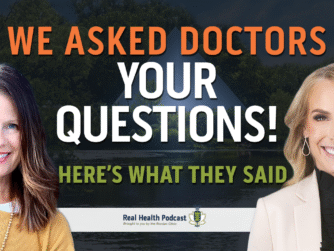
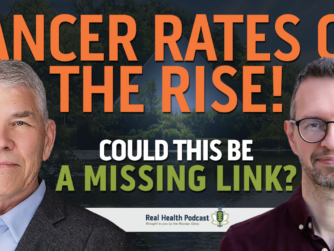
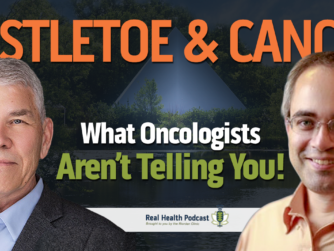
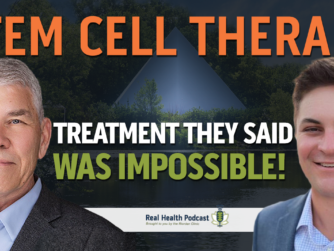
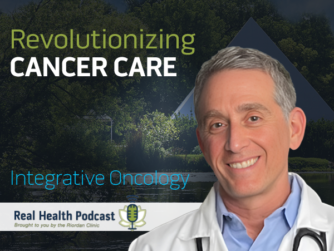
Great info, thank you for sharing! One correction, per Susan G Komen website, “Women in the U.S. have a 1 in 8 (or about 13 percent) lifetime risk of getting breast cancer.” Here is the info on the site with citation. https://www.komen.org/breast-cancer/risk-factor/understanding-risks/